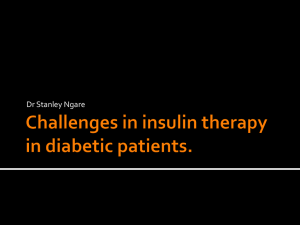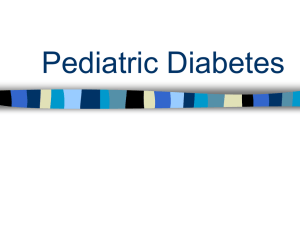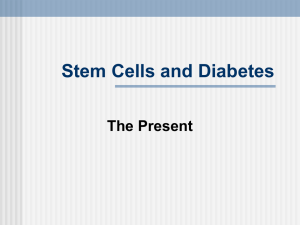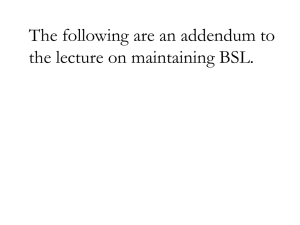Coping With Diabetes
advertisement
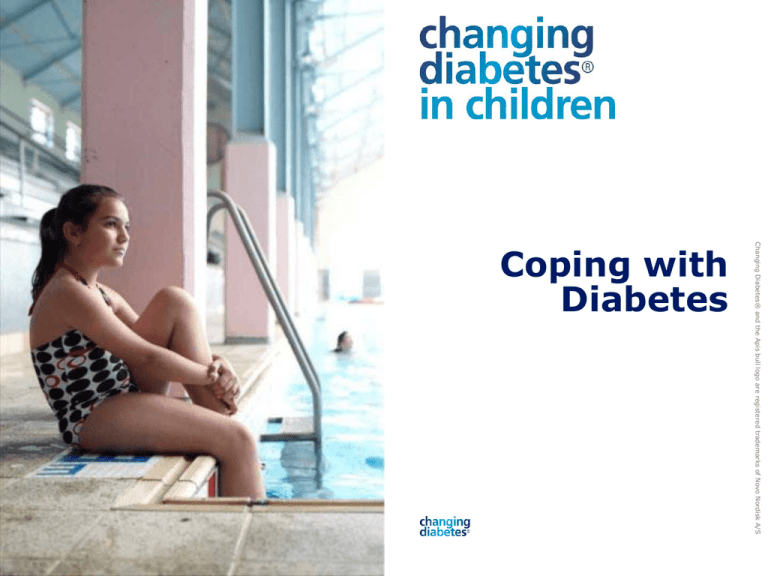
Changing Diabetes® and the Apis bull logo are registered trademarks of Novo Nordisk A/S Coping with Diabetes Programme 1 What to tell the family 7 School issues 2 Dispelling myths and false beliefs 8 Exercise 3 Acute illness 9 Smoking, alcohol and drugs 4 Nutritional advice 10 Pregnancy 5 Storing insulin 11 Fasting 6 Effects of growth on diabetes What to tell the family At diagnosis • First contact is crucial • Can achieve the following: • • • • • Explain diabetes symptoms Enroll the family into care of the child Specifically invite the father and mother Initial diabetes education Dispel myths and false beliefs • Family bewildered and shocked • Be supportive, empathic and caring • Answer comprehensively and respectfully Symptoms • • • • Explain symptoms and signs Diagrams useful Demonstrate glucose values and urine dipsticks Explain mechanism • Insulin deficiency • Unknown cause • Raise questions for future discussion Dispelling myths and false beliefs Myths and false beliefs • Cause of diabetes/ genetics/ environment • Cure for diabetes • Use of alternative medications • Toxicity of insulin • Use of pills for treatment • Infectiousness of diabetes Acute illness Acute illness • Acute illness may cause: • High glucose (hyperglycaemia) • Low glucose (hypoglycaemia) • Ketones • Ketones may occur during, before or after the illness • Children with diabetes do not have more frequent illness • Know how to advise families on management of acute illness Management (1) • Do not stop insulin delivery • May increase or decrease dose • Need frequent monitoring • Glucose 3-4 hourly • Ketones 1-2 times per day • Admit if: • no home monitoring • it is not getting better despite doing all you can at home • Treat illness • Sugar-free medication • No steroids Management (2) • Supportive care • • • • Easily digested food Adequate fluid intake Antipyretics (paracetamol) Consider admission • Adjust insulin doses – never stop insulin • Educate family on management of illness • Provide written guidelines for family Nutritional advice Nutritional advice (1) • Food provides energy for growth and day-to-day functioning • Food intake influenced by • • • • Family functioning Psychological and emotional factors Societal factors Socio-economic factors Nutritional advice (2) • Food (carbohydrate) intake to be balanced against insulin • Food intake to be balanced against activity • Glucose monitoring used to balance food intake, activity and/or insulin dose General dietary guidelines • Use meal plans rather than a diet • Try not to have do’s and don’ts • Keep plans simple and practical Meal plans • Depend on local factors • Calorie restriction for obese patients • Allow for individual choice • Allow flexibility and variety in food selection • Balance financial needs and availability of foods and snacks • Depends on what is available locally Food and insulin • Balance food and insulin • Adapt insulin to suit meal • Different regimens allow change in • Meal plans • Meal frequency Food Insulin Food and insulin Twice daily regimen Multiple daily injections • Regular snacks and meals • Risk of hypos is missed meals/snacks • Emphasise regularity and portion sizes at meals • More flexibility • Less short-acting insulin for smaller meals • Need to understand effects of food and insulin on glucose Teaching about food • Plan for balanced meals • Aim for: • 50-60% carbohydrates • 15-20% protein • <30% fats • Teach food groups and reading food labels • Teach entire family – especially the father and grandparents • Energy requirements change with growth Storing insulin Storing insulin • Insulin is a ‘fragile’ protein medication • Denatured if frozen or in excessive heat • Stored at 2-8°C • Use before expiry date • Once opened, may last • 1 month if not refrigerated • 3 months if refrigerated • Storage of insulin is important Storage of insulin • Clinic and home • Power refrigeration • Not freezer • Back-up generator • Passive/water refrigeration • Underground • Clay pots • Rotate stock by expiry date Questions Changing Diabetes® and the Apis bull logo are registered trademarks of Novo Nordisk A/S

